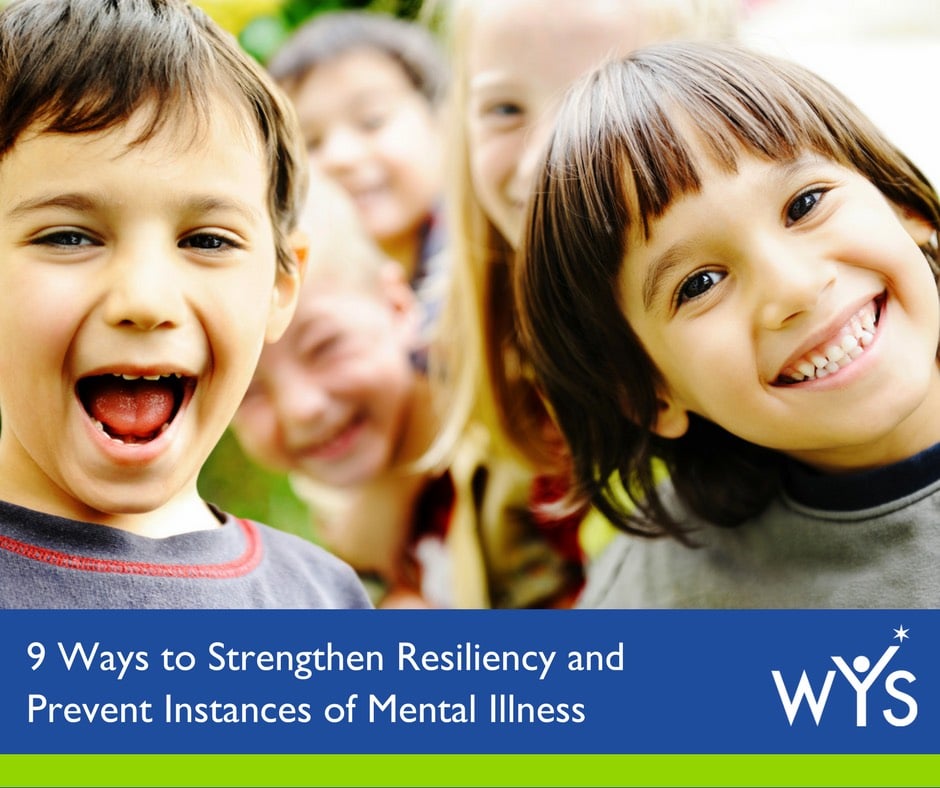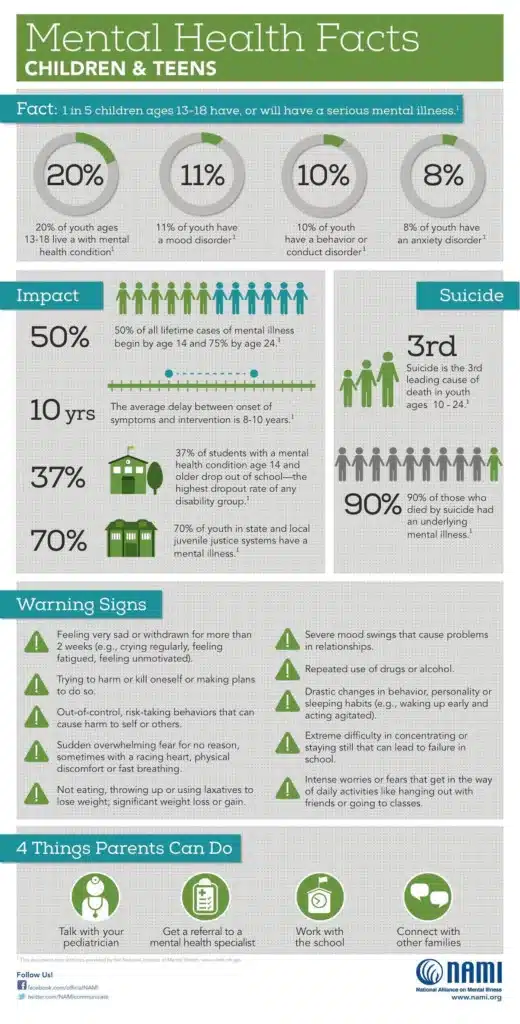
9 Ways to Strengthen Resiliency and Prevent Instances of Mental Illness
There are certain factors, including Adverse Childhood Experiences (ACEs) like abuse, neglect and family dysfunction that increase the likelihood of mental health conditions such as depression, anxiety and posttraumatic stress disorder (PTSD). As we have witnessed and experienced, these childhood adversities can have a profound effect and also are opportunities for building resilience. Resilience, by definition, is the capacity to recover from adverse and/or difficult experiences. When these experiences are recognized and addressed early on the likelihood of mental health challenges escalating to crises decreases.
Since 1972, WYS has provided mental health and behavioral health services to teens, families, schools, and communities in Orange County, California. The approach we take, whenever possible, is to lead with evidence-based or evidence-informed strategies that focus on preventing mental health crises and building resilience.
Resilience is built by improving a variety of different life skills. Outlined below are nine of the strategies that have proven to be influential for strengthening resilience. They were selected based on the Penn Resiliency Program’s Resilience Skill Set (PRP) and supportive evidence of WYS’ approach to preventing instances of mental illness.
 Connections with Family and Friends – It’s been suggested that the best predictor of thriving in life is having a caring dependable adult who believes in you. Many of our youth have difficulty with interpersonal relationships. Improving and/or increasing connections with family members, friends, teachers, etc., allows them to gain life-long coping skills that help them to improve communication, understanding, and relationships with family, friends, and in school. This boosts their confidence and builds their resiliency.
Connections with Family and Friends – It’s been suggested that the best predictor of thriving in life is having a caring dependable adult who believes in you. Many of our youth have difficulty with interpersonal relationships. Improving and/or increasing connections with family members, friends, teachers, etc., allows them to gain life-long coping skills that help them to improve communication, understanding, and relationships with family, friends, and in school. This boosts their confidence and builds their resiliency.- Mechanisms of Communication – After experiencing childhood trauma, youth are faced with the choice of communicating the experience, thoughts, and feelings to a parent, guardian or caring adult. Encouraging all forms of communication, including verbal, non-verbal, written and creative expression facilitates healing. Being able to understand and communicate one’s thoughts, feelings, and experiences through many avenues is a necessary aspect of building resilient behavior.
- Locus of Control – Generally speaking, an internal locus of control is the belief that one’s own efforts influence life outcomes, while an external locus of control is the belief that life experiences are determined by forces outside oneself. For example, many youth blame themselves for the divorce of their parents, when that is not the truth. A crucial component to building resilient behavior in youth is helping them accurately identify things they did control or can control. Despite the childhood trauma they experienced, they have the power to move their life forward in a positive way.
- Self-Regulation – Self-regulation is the ability to manage one’s behaviors and emotions. This ability grows throughout the child development process. Resilient youth and teens who have learned self-regulation, appear to gain inner strength as they manage their emotions and resolve difficult situations. Their resiliency grows with each successful outcome. Coaching kids through difficult situations and helping them navigate step by step, each step building on the other, in a manner that allows them to acknowledge feeling upset, angry, or dissatisfied, while continuing to work through the difficult situation, promotes self-regulation.
- Mental Agility – PRP defines mental agility as “the ability to look at situations from multiple perspectives and to think creatively and flexibly.” This is an exercise for the brain. When youth are challenged to have understanding with empathy, they grow more compassionate. Training their brain to look through a different lens will help youth adapt to new relationships and concepts, thereby building resiliency.
- Self-Awareness – PRP defines self-awareness as “the ability to pay attention to your thoughts, emotions, behaviors, and physiological reactions.” A self-aware person also pays attention to the impact of their actions on their own thoughts, emotions, behaviors, and physiological reactions. Helping youth make this connection between their actions and emotions, etc. builds resilience.
- Self-Esteem – Building self-esteem is a crucial element in fostering resilience in youth as they mature. Self-esteem differs from self-awareness and self-regulation in that it focuses less on understanding who they are and more on self-satisfaction. Communicating appreciation of a person’s attributes and strengths is critical to building self-esteem, especially when they don’t appear to believe it. Encouraging them to accept compliments and avoid negative self-talk develops self-confidence throughout the lifespan.
- Empathy – An empathetic person understands the feelings of others. Developing empathy is a core competency in building resilience. Cultivating a sense of curiosity about the experiences of others, encourage imagining being in someone else’s shoes, and modeling active listening are all ways to build empathy.
- Goal Setting – Goal setting builds the framework for the ability to measure success and achieve a sense of accomplishment. For instance, if a high schooler wants to make it into the wrestling championships, he or she can set the goal and create a plan of action with milestones that move him or her toward that goal. Encouraging course corrections when needed and fostering learning from mistakes is all part of the process of goal setting and achievement process, thus, building resilience.
 May is Mental Health Awareness Month
May is Mental Health Awareness Month
Since 1949, May has been a month that focuses on Mental Health Awareness and raising the visibility of this epidemic. Mental Health organizations such as Substance Abuse and Mental Health Services Administration (SAMHSA), National Alliance on Mental Illness (NAMI), and Mental Health America.
SAMHSA hosts National Youth’s Mental Health Day and NAMI leads nationwide campaigns that are very easy to join and share. Mental Health America reaches millions of people each May to grow the movement to fight the stigma of mental illness. They provide support, educate the public, and advocate for equal care, through events, media, and campaigns.
NAMI’s Childhood Mental Illness by the Numbers:
NAMI gathered eye-opening statistics related to childhood mental illness. We all know a person, family, or community that is struggling and there is hope. The numbers are staggering:
- One in five youth ages 13 to 18 (21.4%) experiences a severe mental disorder at some point during their life, and for youth ages 8 to 15, the estimate is 13%. Only half of youth ages 8 to 15 receive mental health services.
- Over one-third of students with a mental health condition ages 14 and older who are served by special education drop out of school —mental illness has the highest dropout rate of any disability group.
- Suicide is the 10th leading cause of death in the U.S., the 3rd leading cause of death for people ages 10 to 14 and the 2nd leading cause of death for people ages 15 to 24. More than 90% of youth who die by suicide have a mental health condition.
These statistics on mental health represent challenging futures for one-fifth of our youth. They will carry their undiagnosed anxiety, depression, emotional problems, adverse childhood experiences, or toxic stress into adulthood and the next generation. The time is NOW to make a difference. This May add your voice to the movement; then keep it going by sharing with others all year long.
Connect with us on social media. We share strategies, resources, and stories to increase mental health awareness, strengthen resiliency, and prevent mental illness every single day.
Join our photo conversation by taking a photo to show how you cope with or have overcome a mental health challenge by following these 2 easy steps:
- Take a photo that means something to you and include a short caption that shares the significance of your photo. Be sure not to include people who can be identified in the picture.
- Then, you can spread the word by sharing your photo and caption on social media using the following hash-tags: #mentalhealthOC #staywellOC #upliftOC #eachmindmatters






